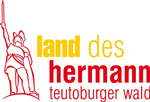Day tours
With our day tours we create incentives for you to simply go out and “cycle” the land of Hermann. Whether for just an hour or maybe the whole afternoon. Our selection of day tours will give you many tips on how to experience a great day in nature. Have fun by biking!
Have fun cycling!
The course begins in Bad Salzuflen and runs in a south-easterly direction past the district of Wüsten. Past the nature reserve “Großer Selberg” the brine trail leads you in a loop over the farmhouses “Bad Seebruch” and “Bad Senkelteich” to Vlotho-Valdorf. From Valdorf the route follows the route of the small railway line back to the state spa Bad Salzuflen.
The southern circuit covers 36.3 km. In the area of the north-lippian mountains and the foothills of the Weserbergland, between Bad Salzuflen and Vlotho, however, there are some ascents to overcome – even if you have to push, here you will be compensated by scenic panoramas!
The route is partly very lonely, especially at the beginning and from Bösingfeld to Schwelentrup. On nice weekends, motorcyclists are often on the small district roads. At the end we will lead you through the slightly undulating Bega Valley back to the parking lot.
Detailed written tour descriptions are difficult to obtain due to unmarked trails, forest roads, agricultural service roads and country roads. For topographical reasons, the route should be followed in the suggested order.
The following locations are on the route: Barntrup – Windmill stump Eilenberg – Ostersiek – Drostenhof – Reine – Eichholz – Bösingfeld – Lindenbrucher Straße – Steinegge – Schaufberg – Steinberg, ehem. NATO-Station, today NABU area with a lookout hill – Schwelentrup – Krusfelder Kaffeestube – Hillentrup – Dörentrup – Spork – Wendlinghausen with castle park – Betzen – Bega – Barntrup.
The tour starts at the parking lot Holstenhöfener Straße in Blomberg. The tour starts through the medieval old town, past the town hall and through the oldest remaining town gate in Lippe, the Niederntor. Follow the cycle path, past the roundabout, turn right there and follow the path marked X6.
Through the open landscape, through fields and meadows you reach Gripshof and from there you can almost see the SchiederSee. (Attention: on a short section the road surface is very bad!) Circle the lake clockwise on the SchiedeSee circular path to the dam wall, from where you have a fantastic view over the water surface and the adjacent Scwalenberger heights.
The tour leads through a beautiful landscape, but there are also hills to overcome. If you do not want to climb up to the Hermann monument, you can also choose an alternative flat route. On the way you will find enough restaurants and pubs for a break.
The Beet Route leads over a length of 38 kilometres past lush meadows and fertile fields of the north-western Lipperland, linking Bad Salzuflen, Lage and Leopoldshöhe. The theme of the tour follows the path of the sugar beets.
The route leads variedly on small paths over the following stages: Bad Meinberg – Möllings Siek – Horn – Bockstal – Holzhausen – Externsteine – Hermannsweg – Silbermühle – Leopoldstal – Rothensiek – Moorstich – Bad Meinberg
Short hike through the gorge of the Silberbach and taste the spring water above the Silbermühle (directly on the cycle path).
The tour connects the districts of Lügde with each other. Learn about the past as a border region, about the flourishing and decline of craftsmanship and the battles for power and supremacy in the districts of Harzberg and Rischenau. Let us take you back to the troublesome times of the stagecoaches, when a long-distance line connected the cities of Kassel and Bremen via Rischenau.
Stories tell of the hopes for wealth and mineral resources at the Silbersieksteich, but also of the departure for the “New World” when many emigrants from Lippe set off for America. The experience station at the Falkenhagen Monastery tells about courageous action against dark superstitions. Here the well-known Jesuit Friedrich Spee von Langenfeld wrote a part of his “Cautio Criminalis”, a work against the witch hunt. Further along the route, an ancient tree witnesses how Lipper cleverly solved their border disputes with Pyrmont. At the end it gets creepy with a gallows and the last executioner of Lügde.
Back in picturesque Lügde, you can relax from the demanding tour with an ice cream or cold beer and enjoy the medieval town scenery in the here and now.




